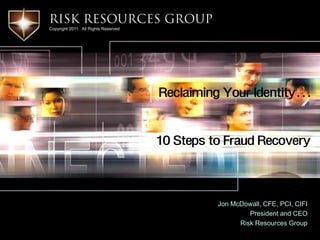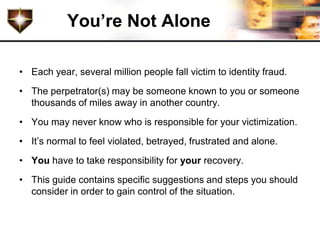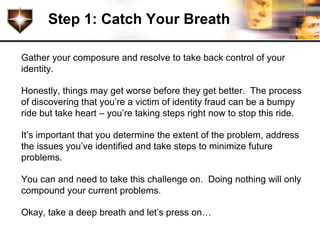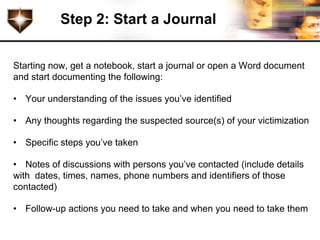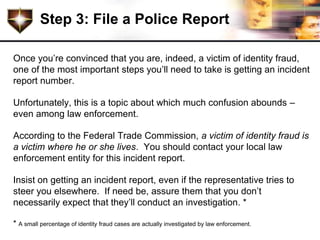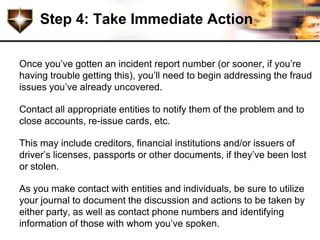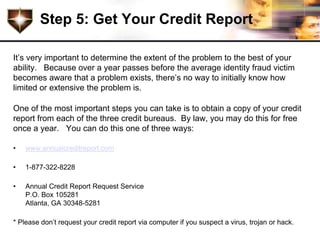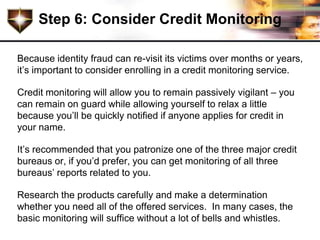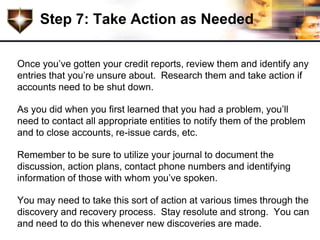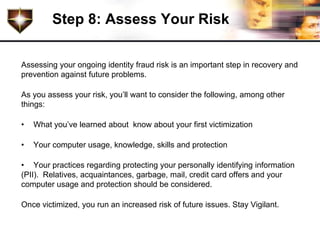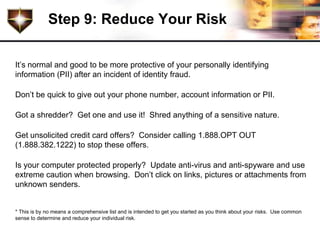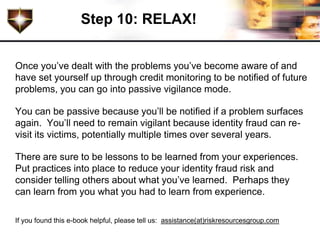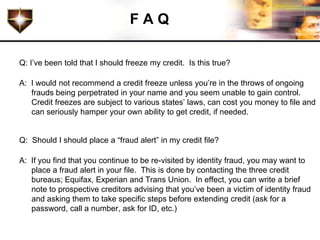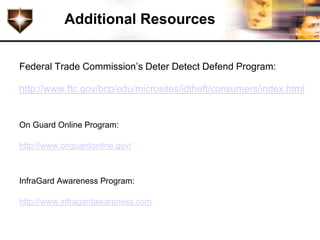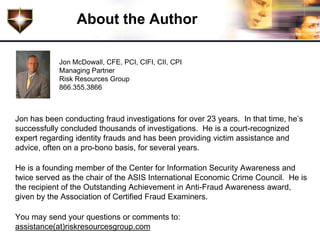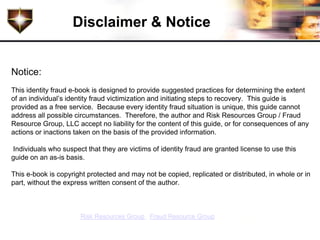Reclaiming Your Identity: 10 Steps To Recovery
- 1. Risk Resources Group Copyright 2011. All Rights Reserved Reclaiming Your Identity… 10 Steps to Fraud Recovery Jon McDowall, CFE, PCI, CIFI President and CEO Risk Resources Group
- 2. You’re Not Alone • Each year, several million people fall victim to identity fraud. • The perpetrator(s) may be someone known to you or someone thousands of miles away in another country. • You may never know who is responsible for your victimization. • It’s normal to feel violated, betrayed, frustrated and alone. • You have to take responsibility for your recovery. • This guide contains specific suggestions and steps you should consider in order to gain control of the situation.
- 3. Step 1: Catch Your Breath Gather your composure and resolve to take back control of your identity. Honestly, things may get worse before they get better. The process of discovering that you’re a victim of identity fraud can be a bumpy ride but take heart – you’re taking steps right now to stop this ride. It’s important that you determine the extent of the problem, address the issues you’ve identified and take steps to minimize future problems. You can and need to take this challenge on. Doing nothing will only compound your current problems. Okay, take a deep breath and let’s press on…
- 4. Step 2: Start a Journal Starting now, get a notebook, start a journal or open a Word document and start documenting the following: • Your understanding of the issues you’ve identified • Any thoughts regarding the suspected source(s) of your victimization • Specific steps you’ve taken • Notes of discussions with persons you’ve contacted (include details with dates, times, names, phone numbers and identifiers of those contacted) • Follow-up actions you need to take and when you need to take them
- 5. Step 3: File a Police Report Once you’re convinced that you are, indeed, a victim of identity fraud, one of the most important steps you’ll need to take is getting an incident report number. Unfortunately, this is a topic about which much confusion abounds – even among law enforcement. According to the Federal Trade Commission, a victim of identity fraud is a victim where he or she lives. You should contact your local law enforcement entity for this incident report. Insist on getting an incident report, even if the representative tries to steer you elsewhere. If need be, assure them that you don’t necessarily expect that they’ll conduct an investigation. * * A small percentage of identity fraud cases are actually investigated by law enforcement.
- 6. Step 4: Take Immediate Action Once you’ve gotten an incident report number (or sooner, if you’re having trouble getting this), you’ll need to begin addressing the fraud issues you’ve already uncovered. Contact all appropriate entities to notify them of the problem and to close accounts, re-issue cards, etc. This may include creditors, financial institutions and/or issuers of driver’s licenses, passports or other documents, if they’ve been lost or stolen. As you make contact with entities and individuals, be sure to utilize your journal to document the discussion and actions to be taken by either party, as well as contact phone numbers and identifying information of those with whom you’ve spoken.
- 7. Step 5: Get Your Credit Report It’s very important to determine the extent of the problem to the best of your ability. Because over a year passes before the average identity fraud victim becomes aware that a problem exists, there’s no way to initially know how limited or extensive the problem is. One of the most important steps you can take is to obtain a copy of your credit report from each of the three credit bureaus. By law, you may do this for free once a year. You can do this one of three ways: • www.annualcreditreport.com • 1-877-322-8228 • Annual Credit Report Request Service P.O. Box 105281 Atlanta, GA 30348-5281 * Please don’t request your credit report via computer if you suspect a virus, trojan or hack.
- 8. Step 6: Consider Credit Monitoring Because identity fraud can re-visit its victims over months or years, it’s important to consider enrolling in a credit monitoring service. Credit monitoring will allow you to remain passively vigilant – you can remain on guard while allowing yourself to relax a little because you’ll be quickly notified if anyone applies for credit in your name. It’s recommended that you patronize one of the three major credit bureaus or, if you’d prefer, you can get monitoring of all three bureaus’ reports related to you. Research the products carefully and make a determination whether you need all of the offered services. In many cases, the basic monitoring will suffice without a lot of bells and whistles.
- 9. Step 7: Take Action as Needed Once you’ve gotten your credit reports, review them and identify any entries that you’re unsure about. Research them and take action if accounts need to be shut down. As you did when you first learned that you had a problem, you’ll need to contact all appropriate entities to notify them of the problem and to close accounts, re-issue cards, etc. Remember to be sure to utilize your journal to document the discussion, action plans, contact phone numbers and identifying information of those with whom you’ve spoken. You may need to take this sort of action at various times through the discovery and recovery process. Stay resolute and strong. You can and need to do this whenever new discoveries are made.
- 10. Step 8: Assess Your Risk Assessing your ongoing identity fraud risk is an important step in recovery and prevention against future problems. As you assess your risk, you’ll want to consider the following, among other things: • What you’ve learned about know about your first victimization • Your computer usage, knowledge, skills and protection • Your practices regarding protecting your personally identifying information (PII). Relatives, acquaintances, garbage, mail, credit card offers and your computer usage and protection should be considered. Once victimized, you run an increased risk of future issues. Stay Vigilant.
- 11. Step 9: Reduce Your Risk It’s normal and good to be more protective of your personally identifying information (PII) after an incident of identity fraud. Don’t be quick to give out your phone number, account information or PII. Got a shredder? Get one and use it! Shred anything of a sensitive nature. Get unsolicited credit card offers? Consider calling 1.888.OPT OUT (1.888.382.1222) to stop these offers. Is your computer protected properly? Update anti-virus and anti-spyware and use extreme caution when browsing. Don’t click on links, pictures or attachments from unknown senders. * This is by no means a comprehensive list and is intended to get you started as you think about your risks. Use common sense to determine and reduce your individual risk.
- 12. Step 10: RELAX! Once you’ve dealt with the problems you’ve become aware of and have set yourself up through credit monitoring to be notified of future problems, you can go into passive vigilance mode. You can be passive because you’ll be notified if a problem surfaces again. You’ll need to remain vigilant because identity fraud can re- visit its victims, potentially multiple times over several years. There are sure to be lessons to be learned from your experiences. Put practices into place to reduce your identity fraud risk and consider telling others about what you’ve learned. Perhaps they can learn from you what you had to learn from experience. If you found this e-book helpful, please tell us: assistance(at)riskresourcesgroup.com
- 13. FAQ Q: I’ve been told that I should freeze my credit. Is this true? A: I would not recommend a credit freeze unless you’re in the throws of ongoing frauds being perpetrated in your name and you seem unable to gain control. Credit freezes are subject to various states’ laws, can cost you money to file and can seriously hamper your own ability to get credit, if needed. Q: Should I should place a “fraud alert” in my credit file? A: If you find that you continue to be re-visited by identity fraud, you may want to place a fraud alert in your file. This is done by contacting the three credit bureaus; Equifax, Experian and Trans Union. In effect, you can write a brief note to prospective creditors advising that you’ve been a victim of identity fraud and asking them to take specific steps before extending credit (ask for a password, call a number, ask for ID, etc.)
- 14. FAQ Q: Should I sign up for an identity fraud recovery service? A: This is a matter of personal preference. As is the case with credit monitoring services, research the services being offered to you. In my opinion, your best and fastest course to recovery involves your direct involvement in that recovery. Even if you sign a Power of Attorney so that someone else can help you, I recommend that you stay engaged. You have too much at stake to become complacent. Q: I’ve been told to apply for a different Social Security number because of my identity fraud. What do you think? A: In a word, NO. This may seem like an easy answer to your identity fraud problem but will not resolve your issues and may actually create others. Unfortunately, there is no quick fix to identity fraud recovery.
- 15. Additional Resources Federal Trade Commission’s Deter Detect Defend Program: http://www.ftc.gov/bcp/edu/microsites/idtheft/consumers/index.html On Guard Online Program: http://www.onguardonline.gov/ InfraGard Awareness Program: http://www.infragardawareness.com
- 16. About the Author Jon McDowall, CFE, PCI, CIFI, CII, CPI Managing Partner Risk Resources Group 866.355.3866 Jon has been conducting fraud investigations for over 23 years. In that time, he’s successfully concluded thousands of investigations. He is a court-recognized expert regarding identity frauds and has been providing victim assistance and advice, often on a pro-bono basis, for several years. He is a founding member of the Center for Information Security Awareness and twice served as the chair of the ASIS International Economic Crime Council. He is the recipient of the Outstanding Achievement in Anti-Fraud Awareness award, given by the Association of Certified Fraud Examiners. You may send your questions or comments to: assistance(at)riskresourcesgroup.com
- 17. Disclaimer & Notice Notice: This identity fraud e-book is designed to provide suggested practices for determining the extent of an individual’s identity fraud victimization and initiating steps to recovery. This guide is provided as a free service. Because every identity fraud situation is unique, this guide cannot address all possible circumstances. Therefore, the author and Risk Resources Group / Fraud Resource Group, LLC accept no liability for the content of this guide, or for consequences of any actions or inactions taken on the basis of the provided information. Individuals who suspect that they are victims of identity fraud are granted license to use this guide on an as-is basis. This e-book is copyright protected and may not be copied, replicated or distributed, in whole or in part, without the express written consent of the author. Copyright 2011. Risk Resources Group / Fraud Resource Group, LLC. All rights reserved.
